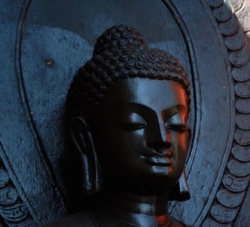Difference between revisions of "Parinirvāṇa"
Jump to navigation
Jump to search
m (Text replacement - "The Buddha" to "The Buddha") |
|||
| Line 1: | Line 1: | ||
[[File:024 n.jpg|thumb|250px|]] | [[File:024 n.jpg|thumb|250px|]] | ||
| − | '''Parinirvāṇa'''; That which is beyond (para) [[Nirvāṇa]]. [[ | + | '''Parinirvāṇa'''; That which is beyond (para) [[Nirvāṇa]]. The [[Buddha]] was said to have attained [[Nirvāṇa]] under the [[Bodhi tree]], and parinirvāṇa when he “died”, thus complete extinction of or release from all [[Attachment]] to the [[Form]]. In technical [[Buddhism]] it refers to complete cessation, non-residual [[Nirvāṇa]], the passing away of [[Buddhas]]. |
See also: [[Parinirvana]] | See also: [[Parinirvana]] | ||
Revision as of 17:04, 12 September 2013
Parinirvāṇa; That which is beyond (para) Nirvāṇa. The Buddha was said to have attained Nirvāṇa under the Bodhi tree, and parinirvāṇa when he “died”, thus complete extinction of or release from all Attachment to the Form. In technical Buddhism it refers to complete cessation, non-residual Nirvāṇa, the passing away of Buddhas.
See also: Parinirvana
